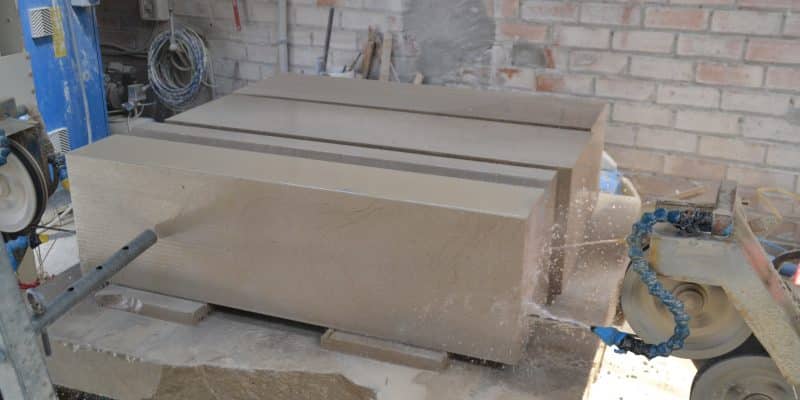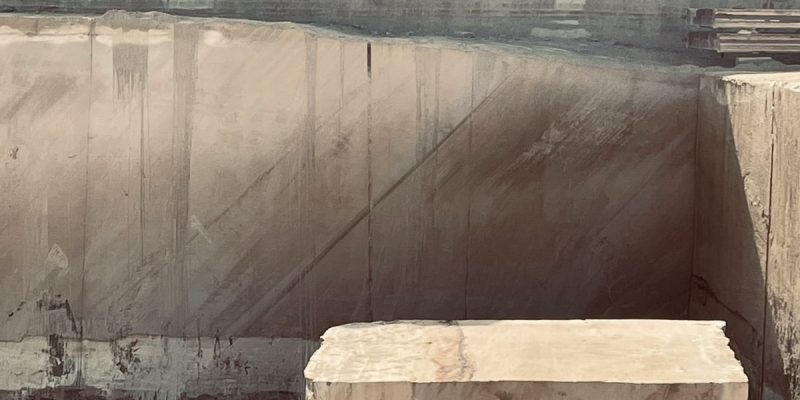When we think about natural stone as a construction material, we tend to picture grand façades, noble paving or decorative pieces full of texture. But before reaching the construction site, each of those elements began with a much more technical — and often invisible — process: quarry cutting. At SAEZ Sandstone, this is not just a logistical step. It’s a strategic decision that defines the quality, durability and performance of the stone in every project.
Technology and craftsmanship: an essential balance
Stone extraction at our La Floresta quarries (Lleida, Spain) is based on a rigorous combination of experience, geological knowledge, and precision technology. It’s not about cutting just anywhere: each quarry face must be carefully read, considering the orientation of the veins, the hardness of the material, the terrain structure and the intended use of the blocks.
Here, the diamond wire saw plays a central role. Unlike more aggressive tools, this machine allows for smooth, clean and accurate cuts that preserve the structural integrity of the block and significantly reduce waste. It operates by rotating a tensioned wire embedded with industrial diamonds, capable of slicing through massive stone blocks with millimeter precision.
This cutting technique not only improves extraction efficiency, but also avoids internal microfractures that could compromise the stone’s structural integrity during handling, finishing or installation.
Cutting at the quarry is part of the design process
The chosen cutting plane at the quarry is never arbitrary: it directly affects the texture, visual pattern, dominant color and finishing possibilities of the stone. In other words, cutting well means anticipating the aesthetic outcome of the final project.
For example, when working with our highly demanded Floresta Marrón Sandstone, it is essential to respect the direction of its natural veining to maintain consistent visual appeal. A poor cut can “break” the visual language of the stone, creating undesired contrasts. That’s why SAEZ applies a tailored technical approach to each block, adjusting cutting parameters to the stone’s unique properties.
The result: better material yield, less waste, and greater predictability for architects and designers who rely on stone that meets both technical and aesthetic criteria from day one.
Made-to-measure cutting for versatile formats
Once extracted, a precisely cut block can be processed into a wide range of formats: paving slabs, façade panels, carved blocks, or special pieces such as stair treads, countertops or urban furniture. This degree of versatility wouldn’t be possible without a well-executed first cut.
Moreover, the initial cut determines the feasibility and quality of the final finishes. A clean, even surface allows for treatments such as polishing, sandblasting, or bush-hammering to be applied with optimal results. These finishes not only enhance the appearance of the material but also influence its technical behavior — slip resistance, weather durability, texture retention, and so on.
An invisible step with visible impact
Although rarely mentioned in brochures or architectural plans, quarry cutting is one of the most impactful phases in the production of stone. A proper cut prevents internal stress, ensures regular surfaces, and facilitates transport and handling throughout the supply chain.
In one of our most iconic projects — the Burberry store façade in Barcelona — the design required perfect chromatic uniformity with uninterrupted visual flow. To achieve this, we selected consecutive blocks cut with a diamond wire saw, preserving the continuous veining across the visible façade. The result was a sober, elegant and technically flawless installation.
The expertise that transforms stone
Machinery alone is not enough. At SAEZ Sandstone, what makes the difference is the human team who reads each quarry face and decides how to approach the cut. From our field engineers to our specialized operators, each block goes through a deliberate process of analysis, testing and constant adjustment.
With over 50 years of experience, we are able to make technical decisions quickly, adapt to shifting conditions in the quarry, and ensure consistent quality in the final product — right from the source.
Conclusion: value begins at the quarry
In a world where natural stone competes with synthetic materials, precision extraction is one of our greatest strengths. Because offering high-quality stone is not enough — we must ensure that quality is preserved from the very first cut through to final installation.
That’s why at SAEZ Sandstone, we treat each block as a unique piece and each cut as a decisive action. Architecture begins in the quarry. And it’s through technique, craftsmanship and precision that we enable stone to speak the language of contemporary design.
📐 Want to learn more about our cutting and extraction processes? Visit our blog and discover how we work with natural stone from the very beginning.
www.saezsandstone.com/blog


